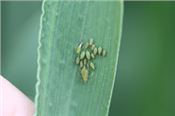Do You Have Aphids In Your Wheat?

DR. SCOTT STEWART
JACKSON, TENN.
If you managed to get a good stand of wheat, make sure you scout closely for aphids. There’s a good bet we will have more aphids than usual this fall because of the warm weather. It you are managing for high yielding wheat, then protecting wheat from transmission of barley yellow dwarf virus (BYD) is important. Below are a couple of points to consider.
Seed treatments such as Gaucho, Cruiser and NipsIt Inside will generally protect against aphids infestations during the fall (and reduce transmission of BYD) .
If a seed treatment was not used, consider making an insecticide application 3-4 weeks after planting. However, I prefer that you scout first and make this application if and when aphid populations reach 3 or more per foot of row BUT before populations exceed 8 or more aphids per foot. BYD may already have been transmitted if you have high aphid numbers. We can often ride low aphid populations into winter during a normal/cooler fall and them clean them up in late winter. That doesn’t work as well on early planted wheat or for normally planted wheat during an usually warm fall.
One final point for future consideration. Planting of before the recommended window can create a Hessian fly problem. If you planted wheat as a cover crop in September or early October, it’s possible that nearby production fields may inherit problems. When feasible, avoid planting production wheat immediately adjacent to an early planted cover crop that also contains wheat. ∆
DR. SCOTT STEWART: IPM Extension Specialist, Unversity of Tennessee